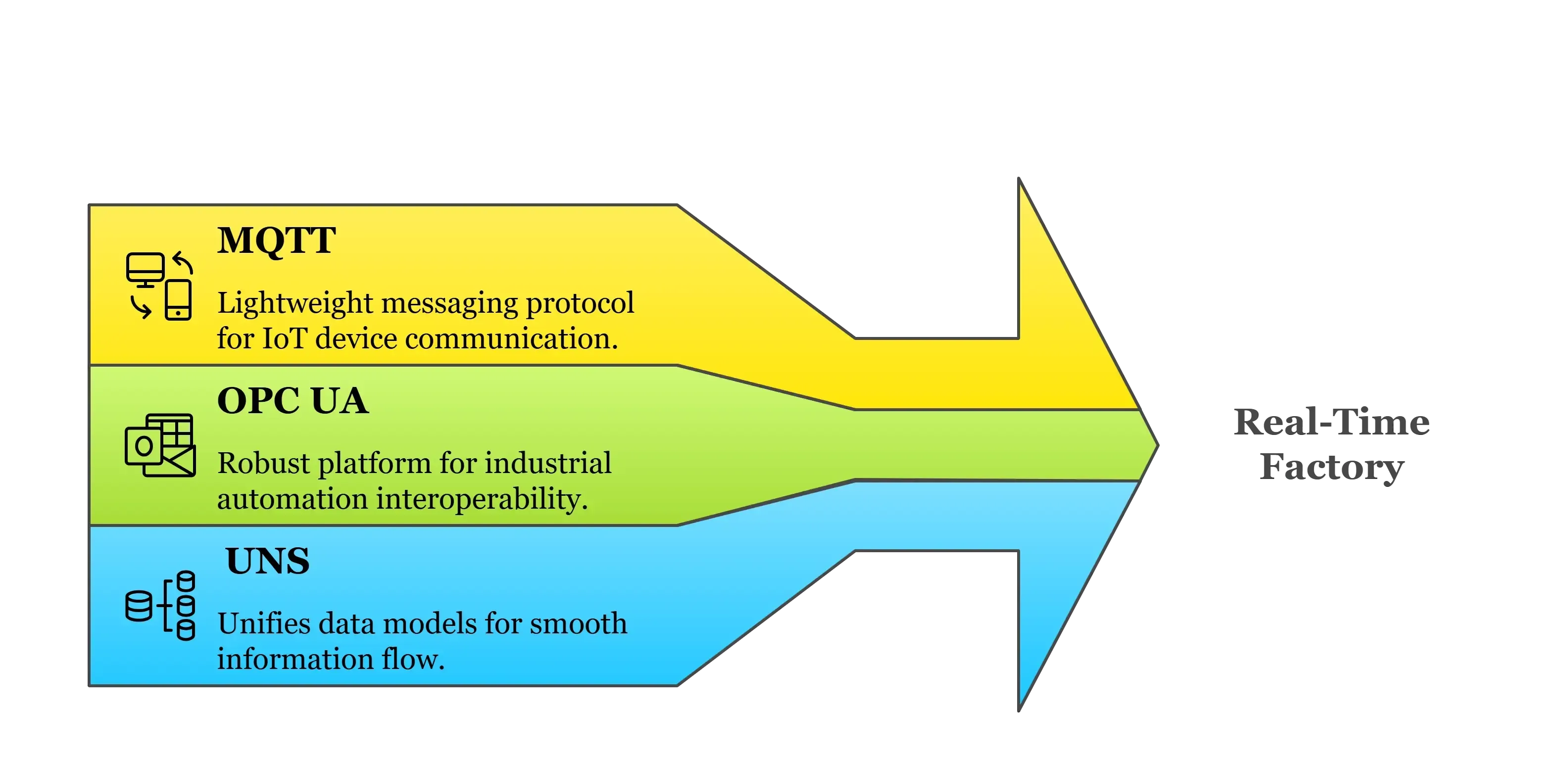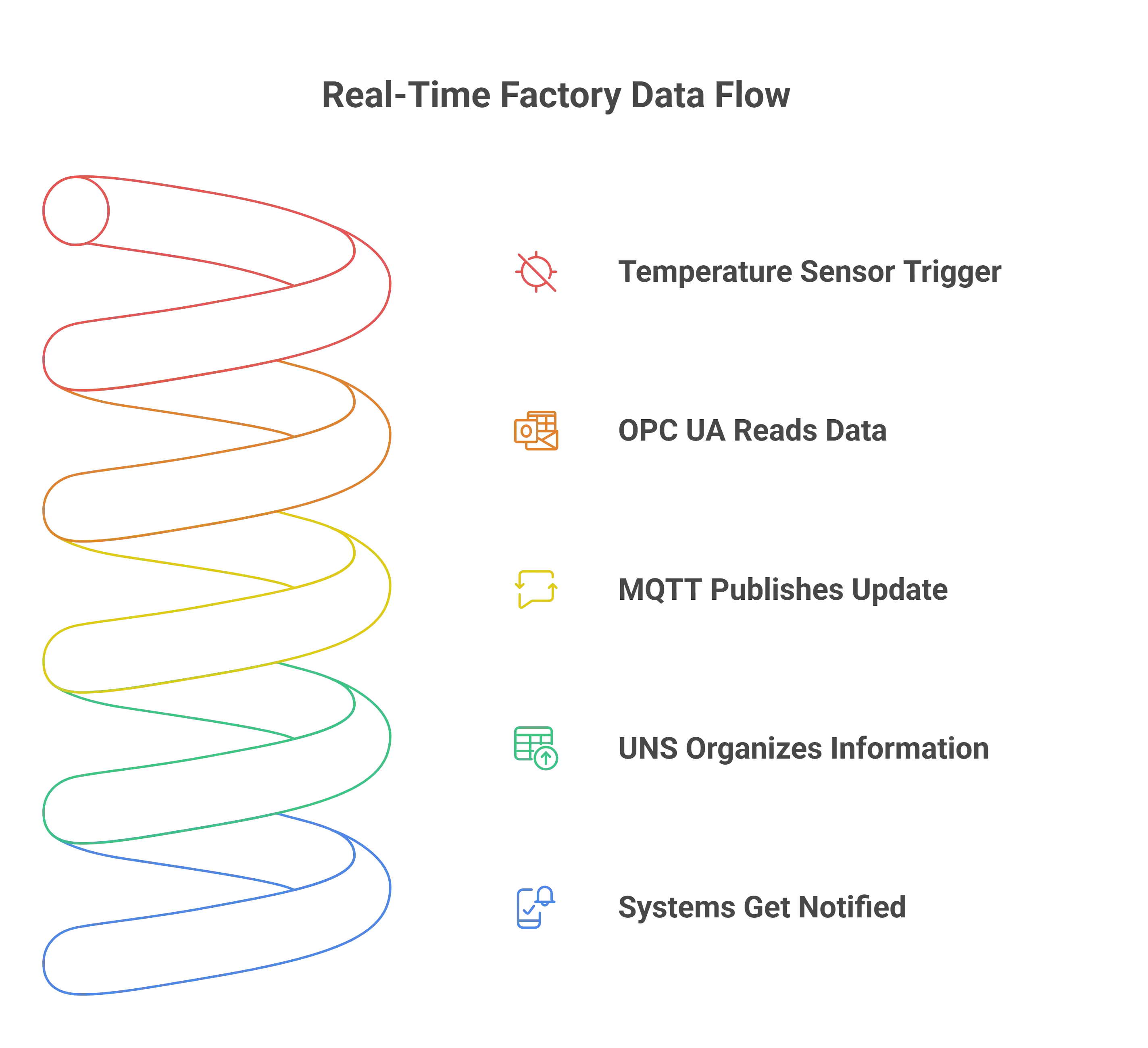Manufacturing is undergoing a massive shift. What once ran on paper-based reports and siloed control systems is now transforming into connected, intelligent, real-time operations. This transition is not just driven by sensors and dashboards—it’s powered by data architectures that can move, structure, and scale information across machines, systems, and people.
In this blog, we’ll explore the backbone of that architecture: OPC UA, MQTT, and Unified Namespace (UNS). Individually, each plays a distinct role. Together, they form the foundation for building a truly real-time factory.

Why the Need for Real-Time?
Let’s face it—manufacturing decisions are only as good as the data they’re based on. If you’re relying on yesterday’s reports to respond to today’s breakdown, you're not just late—you’re losing money.
Here’s what real-time operations enable:
- Spotting issues as they emerge—not after they’ve snowballed into production losses
- Enabling predictive maintenance instead of firefighting after a failure
- Giving every stakeholder—floor operator to plant head—live visibility into what’s happening
- Seamlessly integrating OT (Operational Technology) with IT systems like MES, ERP, and analytics
But all of this requires a system that can pull data from machines, transport it quickly, and organize it meaningfully.
That’s where the trio of OPC UA, MQTT, and UNS comes in.
OPC UA: Accessing Machine Data with Context
Machines don’t speak Excel. They speak in protocols, often proprietary or poorly structured. OPC UA changes that.
OPC UA (Open Platform Communications Unified Architecture) is a machine communication protocol built specifically for industrial automation. It helps pull live data from PLCs, CNC machines, robots, and sensors—and presents that data in a standardized, contextual way.
For example, it doesn’t just tell you “75”—it tells you 75 degrees Celsius, from Machine 2, and whether that value is above threshold. That kind of context is crucial when scaling across dozens of machines or sites.
What makes OPC UA especially powerful is that it’s vendor-neutral. Whether you’re using Siemens, Mitsubishi, or Schneider PLCs, OPC UA can talk to them all. This gives manufacturers the freedom to build flexible, future-proof ecosystems.
MQTT: Moving Data in Real Time
Now that you have clean, structured machine data—how do you move it? That’s where MQTT (Message Queuing Telemetry Transport) enters the picture.
Traditional factory systems rely on polling—asking the machine for updates every few seconds. This puts a strain on the network and still leaves you reacting in intervals. MQTT flips that model. It’s event-driven: the machine publishes updates only when something changes, and any system subscribed to that data gets notified instantly.
MQTT is lightweight, low-bandwidth, and extremely scalable. It’s already used across thousands of IIoT implementations—from automotive plants to power generation facilities.
Think of it as the nervous system that delivers signals across your factory—fast, efficient, and reliable.
Unified Namespace (UNS): One Language, One Structure
At this point, you’ve got structured data (OPC UA) and real-time flow (MQTT). But how do you keep everything organized?
That’s where Unified Namespace (UNS) comes in.
UNS is an architectural approach that creates a single, consistent structure for your industrial data. It’s like a live directory of everything happening in your factory. Every device, tag, and event has its place in a hierarchical topic tree, such as:
factory1/lineA/machine3/statusfactory1/lineA/machine3/temperaturefactory1/lineA/machine3/alarms
This structure is not just for humans—it’s what your MES, ERP, analytics engine, or AI model will connect to. And because UNS is updated in real time (thanks to MQTT), every system that hooks into it sees the current state of operations instantly.
UNS breaks down silos. Instead of having separate integrations between each system, everything talks to a shared, central structure. It’s the digital equivalent of having everyone in the factory on the same page, all the time.
How It All Works Together
Here’s a quick example to bring it all to life:
A temperature sensor on Machine 3 crosses a critical threshold.
- OPC UA reads this data directly from the PLC.
- MQTT instantly publishes the update to a topic like
plant1/lineA/machine3/temperature. - The UNS organizes this information in its hierarchy, reflecting the change in real time.
- Subscribed systems—like dashboards, maintenance apps, or alerting tools—get notified immediately.
There’s no delay, no middleman, no manual checking. The entire factory reacts in sync, based on a single source of truth.

What Makes This Architecture Powerful
This isn’t just a technical upgrade—it’s a business advantage.
With this setup, manufacturers can:
- Reduce downtime by acting on live alerts
- Increase productivity through better coordination
- Enable predictive maintenance by analyzing trends in real time
- Achieve IT-OT convergence without complex integrations
- Lay the groundwork for AI and machine learning with well-structured, contextualized data
And because this architecture is vendor-neutral, scalable, and modular, it works whether you’re upgrading a single line or building a brand-new smart factory.
Final Thoughts
A real-time factory doesn’t start with flashy dashboards. It starts with architecture.
By using OPC UA to access machine data, MQTT to transport it quickly, and UNS to organize it into one shared structure, manufacturers build the foundation for visibility, agility, and innovation.
It’s a shift from disconnected, reactive operations to a unified, intelligent factory floor—one message at a time.
